
Clocks of the Swing Era
More than just Reminders of the Time
Just in case you have a special request, here are some navigational tools
- Watches
- Jefferson Mystery Clocks
- United Metal Goods Clocks
- E. N. Welch Company Clocks
- Ace-Ingraham Clocks
- The Perivale Clock
- The Dreyfuss Big Ben Clock
- The Westclox Moonbeam
- The Numechorn Tymeter
In addition to Clocks, we have a Calendar of Swing Dancing in DC, a Directory of Vintage Clothing Stores and a Guide to 1940s Collectibles. Thanks for tuning in! Feel free to Contact Me if you have questions or want to share photographs and "Spend Some Time" with the rest of the readers.


Time Pieces
Lots of History in a Small Place
Click to Enlarge
There are three Time Pieces in this picture which span the time-keeping requirements of the Swing Era --- the Mickey Mouse watch, the Curvex and the Railroad Watch
Let's start with the Hamilton Railroad Watch in the protective glass bell jar. (Click Here if you want to find out why they call it a "Rairoad watch"). This particular example is a Hamilton Model 992 #7 Double Roller railroad watch with movement serial number 1,631,484 that places its date of manufacture in about 1933; the case is 10 Karat gold-filled in the "Roman Key" style;, probably from the Pennsylvania Railroad; the case serial number is 7,237,198. This watch would have been retired from railroad service in 1947 since its steel spring would be sensitive to the magnetic fields in a diesel engine.
In its Original Box is a 1930s Gruen Curvex, probably the most famous wristwatch ever. These watches are one of the greatest examples of 1930s streamlined design. (Click Here to learn more about Gruen Watches)

The Curvex makes Its Debut
Popular Mechanics July, 1938
Click to Enlarge
In the background is a Mickey Mouse Watch in the shape of a Curvex, something I find to be a fascinating juxtaposition of High and Low culture. Click Here to read about the history of the Mickey Mouse Watch, first made in 1930 by the Waterbury Clock Company (now Timex).
Here is an advertisement for Elgin watches taken from the March 6, 1941 issue of LIFE Magazine that illustrates the variety of "good" watches that was available at the time. For reference, $1 in 1941 would be about the same as $20-30 in 2009, so these watches could not be considered "cheap". The Curvex was about $70, which would place it in the same category as the Rolex watch today. This does not, of course, mean that you could swap a 1941 Elgin watch for a Rolex today.

Advertisement for Elgin Watches
From LIFE magazine, March 1941
Click here to look at another type of collectible, or keep on scrolling for more Clocks.


The Jefferson "Golden Hour" Clock
How They Operate is a a "Mystery"
This is the celebrated Jefferson Golden Hour clock that is an icon of the 1950s -- my very trendy Aunt Helen had one and it was a constant mystery to me about how it worked. Others have had the same feeling, because these are also known as "Mystery Clocks", mainly because the hands seem to float in air without any connection to a motor.
I cannot even begin to do justice to the treatment of Jefferson Clocks because there is a beautiful, well-constructed, well-written and exhaustively detailed site that has everything that you would ever want to know about them. You are hereby commanded to visit Roger Russel's page and send him a very complimentary e-mail.
I shall share with you a very cursory track through the major patents that circumscribe this particular genre of "Mystery Clock." For this, we are indebted to Leendart Prins of the Netherlands, who invented a large number of ways to create the illusion. Basically, the clear glass disk has a hidden rim with gear teeth that is driven by a small gear at the base where the clock face is tangent to the base. Mr. Russell has a large number of photos showing the clock dis-assembled, so you will have no trouble in figuring out how it works. For the "Golden Hour" clock, here are the patents:

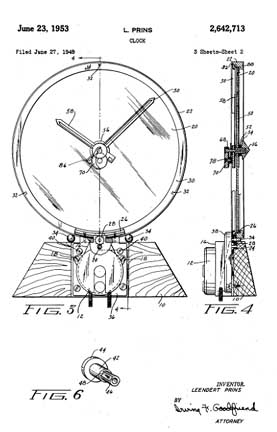

Leendart Prins Patent 2,642,713
The Secret Revealed
Click here if you want to learn how to get Patent Drawings
The minute hand is fixed to the glass disc. At the "hub", the hour hand is fastened to a counterweight device and is moved by a ratchet device connected to the minute hand. This gearing is hidden by the decorative plate over the hub.
A while ago, I came upon another variant of the clock, called the "Golden Minute", also made by Jefferson Electric, of Bellwood, Illinois. Mr. Russel also has the definitive treatment of Jefferson Clock variants, so I will not bore you with the details other than to show you the pictures:


The Jefferson "Golden Minute" Clock
One of a variety of styles available, same basic mechanism
Last week, I was browsing through a thrift store in Chevy Chase, Md and I came upon this poor refugee. It is an "Etalage-Reclame" clock that uses a much earlier Prins patent. The clock is in terrible shape and I will have to do a considerable amount of work to restore it.



The Etalage-Reclame "Mystery" Clock
Yet another mystery
The Etalage Clock (treated in great detail on Mr. Russell's web site) uses two rotating glass discs. In French, etalage means "Display", and lame is a "Blade" and clame is a "Clamp". The minute hand is on one disc and the hour hand is on the other, so this is a kind of display with the blades (hands) clamped together.



Leendart Prins Patent 2,248,195
Two Rotating Disks
Click here if you want to learn how to get Free Patent Drawings
Again, let me express my thanks to Mr. Russell for all his hard work.
Click here to look at another type of collectible, or keep on scrolling for more Clocks.

UNITED METAL GOODS CLOCKS
They Put the Schlock in Clock
Collectible, nonetheless...
Today, we are indebted to our friend Acme Ron of Phoenix for sharing with us his very fine example of a ship clock. These were de rigeur for the mantel in the home of prosperous young couples in the 1930s and 1940s. The tradition of a ship model on the mantel stems from New England, where much of the "Old Money" was made in the China Trade or Whaling. In that case, the ship model represented a constant reminder of the source of the family wealth. Time was told by expensive Tall Clocks.
As people moved to smaller quarters (such as city apartments), space for the tall clock vanished, leading to the wide popularity of mantel clocks. Often, the clock was combined with figurative elements such as dogs, horses, goddesses, or whatever, limited only by imagination and the bad taste of the manufacturer. United Metal Goods of Brooklyn produced a long line of cheap'n'cheesy clocks that have become cultural icons.
However, the ship mantel clock need not be declasse. Here is an example of a mantel ornament in the shape of a stylized ship with sails configured to spell "1939" - no doubt a trendy New Year's Day gift that combines the tradition of a ship modely with Art Deco chrome styling. This object, now very rare and collectible, was manufactured by the National Silver Deposit Ware Company of New York; it was designed by Abraham Solomon of New York and Eugene Volykine of Paris, France.

Solomon and Volykyne's Design patent D-110,826
While we are on the subject of mantle ornaments, here is a globe, supported by two atlantides that would have been just dandy for a massive fireplace in the office of a Wall Street fat cat.
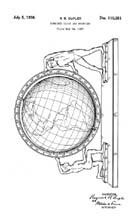
Raymond Dupler Mantel Globe, Patent D-110,351
Click to Enlarge
It is not unnatural that the ship model eventually merged with the mantel clock. The availability of a cheap, reliable electric motor spurred the development of all sorts of mantel clocks, and made possible the mass production of clocks like this.

The Label on the Bottom of the Clock
The ship model clock has lovely chrome sails and uses a very reliable electric motor devised by B. E. Lennehan for the Westinghouse Corporation.


B.E. Lennehan Patent 2,140,365
A Very Reliable Electric Motor
Click here if you want to learn how to get Free Patent Drawings
Our friend Alta sent us these pictures of a similar clock that was owned by her mother.
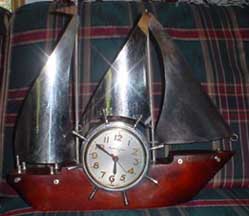

Mastercrafters Ship Clock
The "Sessions" Movement came from United metal Goods
She writes: "...My mom says that the first time she remembers seeing the clock was in either 1960/61 when she was about 6 years old. She said my Great Granny kept it on her mantel until the day she died in 1986. That is when my grandmother had a pile of things to burn and this was one of them. My mom saved it and some other odds and ends and now it sits in her spare bedroom on a shelf. Face of clock reads: Mastercrafters (top part) Clock movement by Sessions Made in U.S.A (bottom of clock face On the back there is a sticker that reads: Mastercrafters Clock & Radio, Chicago, U.S.A..." (Mastercrafters and United shared patents and designs so their clocks are often similar)
The name "Sessions" has its origin in a company owned by W. K. Sessions that manufactured fine clocks. In 1958 the company was bought by Consolidated Electronics Industries of New York. In 1968, the inventory, equipment and tools used in the clock-making division od Sessions was sold to United Metal Goods.
Alta also sent us this photo of another United Metal Goods clock that she recently found:

An Interesting Clock from United Metal Goods in the form of a Balance (Model 207)
Is There a Lawyer in the House?
The foundation of most of these clocks is a remarkable electric motor and gearing designed by Anthony William Haydon between 1931 and 1939. This power system allows the clock to also perform a large number of other functions, such as twirling a cowboy's lariat or moving a figure in a graceful Hula. United Metal Goods made an astounding variety of animated clocks by using the Haydon patents to the hilt.


Mr. Haydon's Revolutionary Clock Motor (Pat. 1,935,208) and Gearing (Pat. 1,977,186)
United Clocks -- tasteless as they were -- could often be found as the grand prize in carnival games of skill. They are therefore also called "carnival" clocks. Here is a wide selection of schlocks (er.. clocks) that were made by the United Metal Goods Company:



Charming Scenes



Animation



Western Theme



Transport



Themes




Anything and Everything!
Our absolute favorite is "The Flame of Life"which shows a naked man and woman -- separated by a thermometer...

The Flame of Life
Alas,there is a downside to this story. "United Metal Goods" is the sad ending to the marvelous legend of E.N. Welch, one of America's great clock makers, our next topic.
Click here to look at another type of collectible, or keep on scrolling for more Clocks.
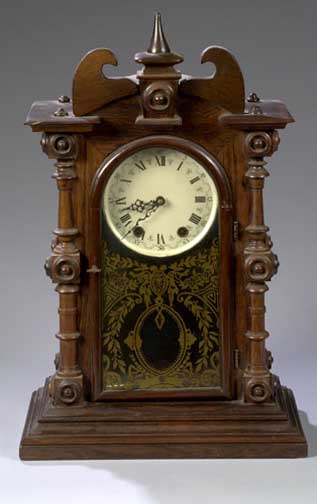
The E. N. Welch Company
High Class Clockmakers Who Fell From Grace
A fetish for opera, particularly sopranos... This is the Adelina Patti Clock
Elisha Nales Welch was the largest and most successful clockmaker for almost all of the last half of the 19th century in Forestville, Connecticut, "Clock-Town USA". His companies, The E. N. Welch Mfg. Co. and it predecessor the Welch Spring Co. produced a wide variety of clocks in great quantities, making Mr. Welsch a multimillionaire in a time when a skilled workman might take home $1 a week...
When Mr. Welch passed away at the turn of the century, the business was taken over in 1902 by the Sessions Company, and product quality deteriorated rapidly. In ten years the products were almost valueless and any connection with the Welch tradition had ended. The Sessions name was bought by the United Metal Goods Mfg. Co. of Brooklyn, N.Y. which produced lower quality "novelty" clocks for the mass market (discussed above).
During Mr. Welch's productive and prosperous period, the outstanding variety of clocks together with imaginative innovations, inventions and improvements attracted a group of devotees who have specialized in collecting these clocks. Mr. Welch, in turn, was an ardent fan of the opera and stage, and named many of his clocks after the great singers, musicians and actors of his time. Apparently his most popular was the tempestuous Adelina Patti whose name appears many varieties of shelf clocks.

The Adelina Patti Clock Label
Very Early - made by the Welch Spring Co.
Others names such as Arditi, Sembrich, Damrosch, Auber, Wagner, Dolaro, Gerster, Scalchi, Verdi, and many others adorn a large variety of clock case styles. [Fortunately for Mr. Welch, he was able to get away with this in an age before agents could extract a royalty for use of their clients' names.]

The Jenny Lind Clock
Made under license to the Ingraham Company (see below)
OTHERS:
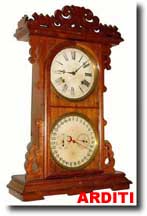








These early clocks have captured the attention of serious clock collectors to a point where now Welch clocks have brought prices approaching those with more prestigious labels.
The process of product debasement is not new -- take a look at our page on Drug Store appliances -- it illustrates how other quality products such as toasters and mixers were adulterated for sales to a mass market. Those looking for more information about Welch clocks should see:
Welch Clocks, by Tran Duy Ly, 8 1/2 x 11", 304 pages, soft cover $32.95, hard cover $39.50, 778 black and white illustrations. Pub. 1992 by Arlington Book Company, 2706 Elsmore Street, Fairfax, Va. 22031.
Click here to look at another type of collectible, or keep on scrolling for more Clocks.


Two Streamlined Clocks
Thanks to 40s Phil
These two clocks belong to the celebrated 40s Phil of Central Indiana. Here's what Phil has to say about them: "The chrome (actually it's just pot metal that I buffed out) clock is a 'Fleetwood' made by Ingraham clock company. The dark colored set is a clock/timer/salt and pepper combo that sat on an old 'quality' stove."
Click here to look at another type of collectible, or keep on scrolling for more Clocks.
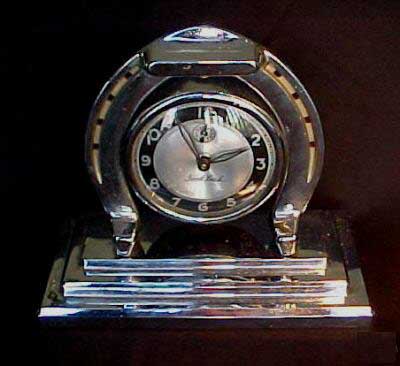
Ingraham "Ace" Horseshoe Clock
Every Mobster's desk should have one!
This is an Ingraham "Ace" alarm clock, set inside a heavily chromed racing horseshoe. The face is silver plate and is engraved with the words "Good Luck". It is about 9 inches wide and 8 inches high. This is what the Ingraham Ace looked like without the horseshoe:
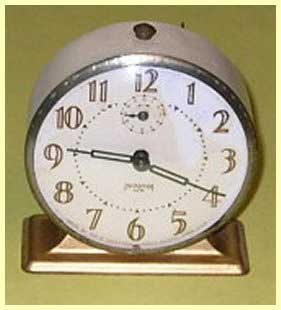
The plain Ingraham Ace Alarm Clock

The Original Box
The clock keeps excelent time although I have to wind it every day. You see these at stores in the $50 range. Most are non- functional because the spring wears out. Plan on spending at least $50 more to get one working. We have seen these on e-Bay regularly. Here are some more views of the horseshoe clock.

Oblique View

The Back

Closeup of the Dial
We got this as a gift from Dan Ganpel, our friend from Montreal who was a zoot suiter during the 1930s. Dan is also the source of all those spectacular hand embroidered bowling shirts that we wear. Dan owned a tailor shop on F street downtown for nearly 50 years until he retired. He embroidered the mission patches that were worn by the Apollo astronauts on their trips to the Moon.
This object is a MUST for any Mobster or Gambler who needs to have a fully equipped desk! This is a mandatory prop for any B movie. When I finally get my Nightclub, this is going to be the very first object that I place in my office!
One of our readers sent us this photo of a clock made by the E.N. Welch company (see above). This clock predates the Ingraham "Ace ", and it has some very unusual -- and even surrealistic features: the clock rests on an anvil, and the supports are the legs and hooves of horses. Mr. Welch had some very interesting ideas.

E.N. Welch Co. Horseshoe Clock

Good Luck!

The Back
The history of the Ingraham Clock Company is of some interest, particularly the rise and fall of the company based on speculation and market shakeout.
Before 1840, clocks were manufactured mostly by individuals or family-owned companies. In 1840, Chauncy Jerome built America's largest clock factory in Connecticutand started shipping clocks all over the world. In an axis from Hartford, through New Britain, to New Haven, other clockmakers sprang up including the Ansonia Clock Company, the Waterbury Clock Company, the Seth Thomas Company, E.N. Welch Company, Ingraham Clock Company, and Gilbert Clock Company. Connecticut became the major source of clocks and attracted a large new population of skilled engineers and workmen.
By 1851, there were over 30 clock factories in this country, but the spinoff in mechanical engineering talent and knowledge spread to many other areas beyond timekeeping. This mass of skilled human resources led to the industrial domination of the Northern states and was a large factor in the victory of the Union in the Civil War. The rapid growth of clock-making and its business and organizational concomitants was greatly spurred by the advent of the railroads and the public's new found need for precise management of time. When the train came at 8:05, it was not good enough to reckon by the sun. The mass market for clocks is one of the first great "growth" industries in America and was one of many speculative bubbles. This was quite parallel to the digital revolution of the 1990s.
From 1840 up to the 1920s, millions of clocks were produced, of which many surviving examples can still be found. These were high quality products, a source of pride for Americans. Alas, there was considerable excess capacity for manufacturing clocks and a shakeout was in order.
During the stock market crash of 1929, many of the large clockmaking companies failed or were reorganized. The great Ansonia Clock Company sold its assets to the Russian government, shipping its machinery and equipment overseas. the Seth Thomas Clock Company became a part of General Time Instrument Company (now TIMEX). During this period, the emphasis was on cheaper mass-market "Drug Store" clocks of which the "Ace" is a good example. We are indebted to Elof L. Carlson of Bristol, Connecticut (an employee of the Ingraham Clock Company) for the mechanical design of the "Ace." The typography for the face was designed by Fred Weindel of Allentown, Pennsylvania.



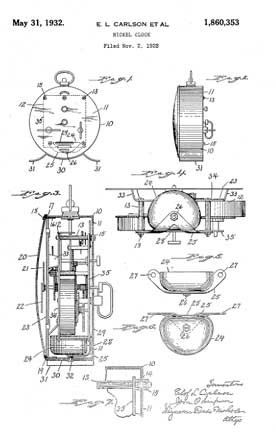
Ingraham Ace Patents The lower left drawing is important if you take the crystal off
Click here if you want to learn how to get Patent Drawings
Of the original giants of the clock industry only three exist today. They are all currently divisions of larger companies. Seth Thomas is now a division of Talley Industries, Gilbert Clock has been replaced by the Sparta Corporation, and the Ingraham Clock Company is now a division of McGraw-Edison. No spring-powered clocks are currently being mass-produced in the United States.
Click here to look at another type of collectible, or keep on scrolling for more Clocks.

Perivale Art Deco Clock
From Great Britain
Click to Enlarge
We simply love the lines of this wooden Art Deco clock from the 1930s. This is the "Guaranteed Perivale Clock", manufactured by (what else) The Perivale Clock Manufacturing Company Wadsworth Road, Greenford, Middlesex (Great Britain). There is a woderful label on the inside case with a very official looking wax seal attesting to the "Five Year Guarantee", although the list of exceptions is fairly lengthy. The seal, featuring Britannia ruling the seas with her trident, reminds us that this is an "All British Clock".
Perivale used the "Anvil" trademark that appears on the bottom right-hand corner of the back plate. Their clocks were initially marketed by Andrew and Co. Ltd. 67 to 68 Hatton Garden, London. The "Britannia" trademark was in use for Perivale clocks in 1937 when they were being a marketed by the Bentima Co Ltd..
The clock has a seven day movement (i.e. you have to wind it every week) and a very pleasant Westminster chime. It is very sensitive to heat (the pendulum expands and contracts) and takes a lot of regulation to keep on track. The method of regulation peculiar to these clocks appears to be somewhat complicated but it enables the pendulum length to be adjusted by means of a small lever through a slot in the dial above the figure 12. Other features include a lead pendulum and Bob encased in brass; pillars secured by nuts; barrels easily detachable by letting down the spring, and removing two screws on the strap plate without further disassembly of the movement; self-correcting chimes and provision for chime / silent.
On balance, it looks a whole lot better than it works. This is one of the few examples of 1930s technology that is NOT superior to contemporary products. It would keep a whole lot better time if we threw away the "All British" works and replaced it with a $3.95 battery operated quartz movement.

Henry Dreyfuss Big Ben Alarm Clock
The Classic Disposable Timepiece
Click to Enlarge
Henry Dreyfus (1904-1972) had a profound impact on the daily lives of millions of Americans. Through industrial design, the process we use to shape environments, transportation, products, and packaging, he raised the standards of American industry. A constant focus on the needs of the average consumer characterized his work. Dreyfuss came to prominence in the 1930s from a background in theatrical design. He worked as an apprentice to Norman Bel Geddes, a genius of stage and industrial design. In 1927, Dreyfuss set out on his own and within a few years was recognized as a bright young talent.
Referring to himself as an industrial designer, he opened an office in New York in 1929 and soon distinguished himself as a designer for mass production. By favoring practicality over art deco and streamlined styling, he gained the respect of his clients.
Although his clients incorporated the creme de la creme of American industry --- Honeywell, AT&T, Polaroid, and the New York Central Railroad --- Dreyfuss lent his genius to the creation of this commonplace item. You might like to look at pictures of his iconic work for the Twentieth Century Limited train on our Streamlined Locomotives Page.
In November of 1938, Dreyfuss submitted an application for a design patent for the "Big Ben" alarm clock, a product of the General Time Instruments Corporation of NYC (later this became "TIMEX"). He was awarded patent no. Des. 114,262 for his "design for a clock casing" on April 11, 1939. His obsession with circles continued and led to his very famous design for the Honeywell Thermostat which has been in continuous production since the 1940s. The Big Ben clocks are widely reproduced.

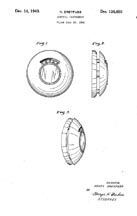
Henry Dreyfuss in Circles
Big Ben Patent D-114,262
Honeywell Thermostat Patent D-136,850
Click to Enlarge
This was sold for about a dollar in drug stores all over the country. The style evident in the design have made these a real classic, and they are now worth upward of $50 in mint condition. This example works and keeps very accurate time.
Click here to look at another type of collectible.
THE WESTCLOX "MOONBEAM"

Advertisement for Westclox Products
From the September 18, 1950 issue of LIFE Magazine
The Moonbeam is at about "3 O'Clock"
Click to Enlarge
In 1949, Westclox came out with a novel design for an alarm clock -- in addition to sound, the clock used a flashing light to gently awaken the owner. The combination light and clock was put into a very distinctive half-round case. We were surprised to learn that the "Moonbeam"was designed by Paul Darrot, having believed for years that it was designed by Henry Dreyfuss. The original moonbeam came in a white Bakelite case with a choice of a brown or white dial. It should be noted that over time, white Bakelite changes color to a caramel shade. (I have some bakelite penguins frolicing on caramel-colored ice cubes...)



The Westclox "Moonbeam"
Left: Dark Dial Variant
Middle:Paul G. Darrot Design Patent D-162,391
Right: Light Dial Variant
Click to Enlarge
Click here to look at another type of collectible.
THE NUMECHRON "TYMETER"
This is a faux digital clock that was invented in 1935 by Mr. Frederick A. Greenawalt, for which he received US Patent 1,990,645. It was marketed under various guises by the Pennwood Numechron Company of Pittsburgh, Pennsylvania. However, this nifty little model with a face that looks like a Television set really took off, and soon it was de rigeur to have a Tymeter to keep up with the Joneses. This model has a light AND it glows in the dark! A sticker on the back indicates that it was made in October 1957 at the height of the fad.



The Numechron Tymeter
US Patent No. 1,990,645
Click to Enlarge
Click here to look at another type of collectible.
Counter for the Entire Site (not just this page..)
Home | About Lindy | Last Week's Reviews | Upcoming Events | 1940s Collectibles
The Guide - Establishments - Travel - Accessories
Music | Links | Photo Gallery | Extras | Contact